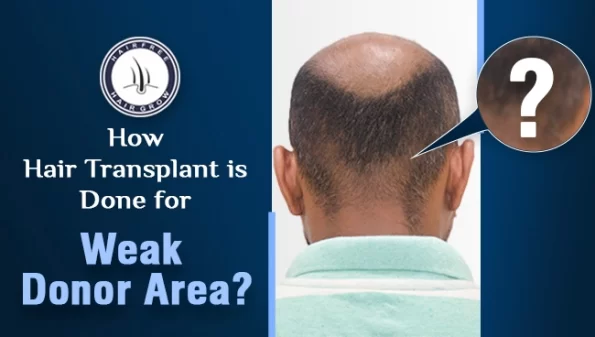Are you struggling with hair loss and have a weak donor area for a hair transplant? You’re not alone. Many people face this issue when considering a hair transplant. However, there is a solution – hair transplant for weak donor areas. Curious about the hair transplant donor area? Discover how it plays a crucial role in achieving natural-looking results!
In short, a hair transplant for weak donor areas involves using hair from other parts of the body or using specialized techniques to extract hair from the weak donor area itself. This allows for a successful hair transplant even with limited donor hair available. In this article, we’ll explore the various methods of hair transplant for weak donor areas and provide insights from renowned hair transplant experts to help you make an informed decision.
But that’s not all – we’ll also delve into the common myths surrounding hair transplants for weak donor areas and provide tips on how to prepare for the procedure. So, whether you’re a man or a woman, and no matter what your hair loss concerns are, this article will provide you with everything you need to know about hair transplant for weak donor areas.
Importance Of Donor Area in Hair Transplant
The donor area in hair transplant is extremely important because it provides the hair follicles that will be transplanted to the recipient area. These follicles need to be healthy and strong, with a good texture and color, in order to produce satisfactory results. The best donor areas are those that are located on the sides and back of the scalp, as these areas are typically resistant to DHT androgen, which can cause hair loss in other parts of the scalp.
It is also important to note that the amount of hair that can be harvested from the donor area is limited, so the surgeon must carefully plan the transplantation process to ensure that enough follicles are available to achieve the desired results. Patients who have weak donor areas may require multiple transplant sessions to achieve the desired level of hair density.
How To Overcome The Issues with Weak Donor Areas for Hair Transplants?
When it comes to hair transplants, a common issue that some individuals face is having a weak donor area – an area where the hair is resistant to hair loss and can be used for transplant purposes.
To overcome this issue, hair transplant surgeons may examine other areas of the body that have hair that is thick and resistant to DHT, such as the beard. They may also look to the stomach and chest area, as the hair there may be thin but still thick enough to look like scalp hair.
In some cases, hair transplant surgeons may combine donor hairs from multiple sites to achieve the desired outcome. However, it’s important to note that artistic skill is necessary to ensure the precise outcome of hair transplantation.
While hair from the legs and hands can also be used as a last resort, this is not typically recommended as the hair may be too thin to be visible on the scalp and may have a longer and more unpredictable growth cycle. Ultimately, it’s important to consult with a qualified hair transplant surgeon to determine the best course of action for your individual situation.
In addition to the options mentioned above, there are a few other ways to overcome issues with weak donor areas for hair transplants:
Platelet-Rich Plasma (PRP) Therapy
PRP therapy involves injecting the patient’s own platelet-rich plasma into the scalp to stimulate hair growth. This can help improve the quality of existing hair and boost the results of a hair transplant.
FUE (Follicular Unit Extraction) with Body Hair Transplantation
In this method, hair follicles are extracted from other areas of the body that have thicker hair, such as the chest, beard, or legs, and transplanted onto the scalp. This technique is suitable for patients with weak donor areas as well as those who have already undergone multiple hair transplant surgeries.
Scalp Reduction
This surgical procedure involves removing a portion of the scalp that has weaker hair growth and pulling the remaining scalp together to cover the area. The result is a smaller area of baldness that can be covered with hair transplantation. However, this technique is not commonly used today due to the availability of more advanced methods.
Hair cloning
This is a developing technology that involves taking healthy hair follicles from the patient’s scalp and cloning them in a lab. The cloned follicles are then transplanted back onto the scalp, creating new hair growth.
It’s important to discuss all of your options with a qualified hair transplant surgeon to determine the best course of action for your specific needs and goals.
How Does a Weak Hair Transplant Donor Area Affect the Procedure?
A weak donor area can significantly affect the success of a hair transplant. The donor area is the site from which the hair follicles are extracted, and it plays a crucial role in determining the number and quality of follicles available for transplantation.
If the donor area is weak, meaning that there aren’t enough healthy hair follicles available, it can limit the amount of hair that can be transplanted and result in less than satisfactory results. In some cases, a weak donor area may make a person ineligible for hair transplantation altogether.
Additionally, people with certain types of hair loss, such as diffuse unpatterned alopecia or cicatricial alopecia, may not be good candidates for hair transplants even if they have a strong donor area. This is because these conditions affect the quality of the hair follicles themselves, making them unlikely to survive the transplantation process.
Finally, age can also be a factor in determining whether someone is a good candidate for hair transplantation. Younger people, under the age of 25-27 may not be suitable candidates as their hair loss pattern and extent may not be fully developed, leading to unpredictable results.
Overall, a weak donor area can pose challenges for hair transplant surgery, so it’s important to speak with a qualified hair transplant surgeon to determine the best course of action based on your individual situation.
Conclusion
In conclusion, hair transplant is an effective solution for people with weak donor areas. The procedure involves extracting healthy hair follicles from other areas of the scalp and transplanting them to the balding areas. However, it is important to note that not all individuals are suitable candidates for hair transplant, and it is crucial to consult with a qualified hair transplant surgeon to determine the best treatment plan.
Written By
MD (Skin & VD)
Dr. Sanmukhani is a true artist in the field of hair transplantation. With a compassionate approach, she ensures that even patients with weak donor areas achieve remarkable results. Her commitment to excel in hair transplantation is truly commendable!
Disclaimer
We’ve made all possible efforts to ensure that the information provided here is accurate, up-to-date and complete, however, it should not be treated as a substitute for professional medical advice, diagnosis or treatment. See Detailed Disclaimers Here.



